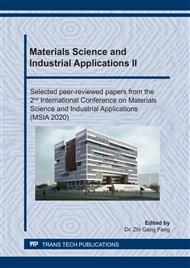[1]
Y.G. Yang, X.L. Bao. Graphite furnace atomic absorption spectroscopy for determination of calcium and magnesium in brine. Salt Industry and chemical industry, 2006, 35(4):27-28.
Google Scholar
[2]
P. Li, L.Z. Yao, Z.B. Lv. Determination of Lithium in mineral water by atomic absorption spectrometry and flame emission spectrometry. Journal of Fushun Petroleum Institute, 2003, 23(1): 26-28.
Google Scholar
[3]
X.F. Xie, M.B. Luo, Y.Y. Shi. Direct determination of potassium, sodium, calcium, magnesium, silicon, lithium and boron in geothermal hot spring water by ICP-AES. Spectroscopy Laboratory, 2000, 17(6): 701-706.
Google Scholar
[4]
J.Z. Sun, X.C. Deng, S.T. Song. Determination of trace impurity ions in high purity lithium chloride by ion chromatography. Sea Lake Salt and chemical industry, 2005, 34(3): 24-26.
Google Scholar
[5]
S.X. Chang, G.Y. Zhang. Constant determination of lithium in brine -- indirect volumetric method for over-iodate. Sea Lake Salt and chemical industry, 1995, 24(4): 36-38.
Google Scholar
[6]
L. Luo, W.Y. Cheng, J.Y. Yang. Separation and determination of lithium in brine by manganese dioxide ion sieve. Sea Lake Salt and chemical industry, 1997, 26(6): 35-38.
Google Scholar
[7]
S.F. Mu, K.N. Liu. Methods and applications of Ion Chromatography. Chemical Industry Press, Beijing, 2000: 6.
Google Scholar
[8]
D.D. Wu, H.S. Huang, G.Y. Shen. On the selection of chemical sensitizer on lead by flame atomic absorption spectrometry. Journal of Shaoguan University, 2014, 35(8): 58-60.
Google Scholar
[9]
W.X. Li, B.Q. Zhang. Effect of Acid on Determining Ca by Atomic Absorption Spectrometry. GLASS & ENAMEL, 2002, 30(6): 30-31.
Google Scholar
[10]
C. Ouyang, J.H. Chen, Z.H. Zhu. Optimization of analytical conditions of determination of sodium by flame atomic absorption spectrometry. Journal of Food Safety & Quality, 2017, 8(5): 1872-1876.
Google Scholar
[11]
D.D. Wu, W.Y. Hu, J.S. Fan. The Effects of Different Acidities on the Calcium Contents Determination by FAAS. Journal of Shaoguan University, 2015, 36(8): 37-40.
Google Scholar
[12]
G.F. Hao. Analysis of four quantitative methods in AAS. Technology Outlook, 2016, 26(14): 190.
Google Scholar
[13]
Y.X. Zhou, Z.B. Sun, J.P. Qiu. Interference factors and elimination methods in FAAS analysis. Chemical Enterprise Management, 2006(Z1): 150-156.
Google Scholar
[14]
Z. Wang, Y.J. Wang, H.L. Zhang. Several Factor that Affect Sensitivity of Flame Atomic Absorption Spectrophometer. Insreumentation Analysis Monitoring, 2006, (2): 42-43.
Google Scholar
[15]
J.X. Chang, L.J. Ma. Study on flame characteristics of atomic absorption spectrophotometer. Mineral Resources and Geology, 2013, (27): 95-97.
Google Scholar


